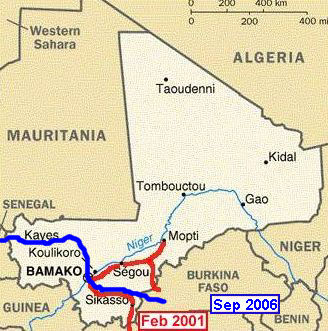 10/2/01 An easy friendly border crossing and after lunch,
our left overs being quickly consumed by street children, we rode past cotton
fields, mud huts and mud grain storage silos to Sikasso, 560 km for the day.
10/2/01 An easy friendly border crossing and after lunch,
our left overs being quickly consumed by street children, we rode past cotton
fields, mud huts and mud grain storage silos to Sikasso, 560 km for the day.
This is part of the Seventh section of our around the
world trip.
Complete Trip Overview & Map
Coming from Cote d'Ivoire
 10/2/01 An easy friendly border crossing and after lunch,
our left overs being quickly consumed by street children, we rode past cotton
fields, mud huts and mud grain storage silos to Sikasso, 560 km for the day.
10/2/01 An easy friendly border crossing and after lunch,
our left overs being quickly consumed by street children, we rode past cotton
fields, mud huts and mud grain storage silos to Sikasso, 560 km for the day.
11/2/01 We had not encountered the famed French people will only speak French and not English in France, finding the people very willing to assist us in English. However we are encountering it more and more from native Africans. Why do you come to a French speaking country if you can't speak French is often asked. We visit many countries and can't learn all the languages is the answer. Well try and speak French is their answer. As if we through trying now will be able to master a language in the next ten minutes. Travellers who have a little French are laughed at and perhaps they think we would be rude enough to do the same if they tried to use their little English, which is usually revealed before we are allowed to proceed. Travelled the 300 km to Bamako.
12/2/01 There are many small countries in West Africa
and obtaining visas can take up considerable time. A Guinea visa issued same
day here and the Senegal visa we collect tomorrow. Thriving street money changers
gave us enough CFA francs and meeting many other travellers filled the day.
The Mission Libanaise is the closest thing to a backpackers in West Africa
we have seen. In the middle of town with a large untidy courtyard yet at
the crossroad's to the desert and west coast, the end of the train line ensures
a steady stream of humpbacks.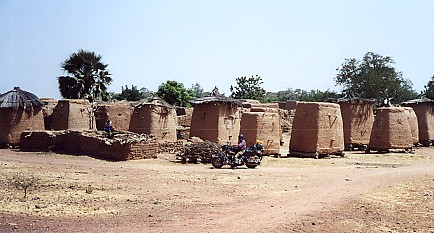
13/2/01 Talking takes such a long time, the more it happens the less that is achieved.
14/2/01 The harmattan wind with it's incredibly fine Saharan dust has been blowing each day since we have arrived in Bamako. It slowly settles to the ground covering everything, making everything you touch seem drier than it should be in the dry heat. Nothing can be kept clean as within minutes a fine layer reappears.
15/2/01 If there is a rumour of a shortage of a product
people will hoard it and create a shortage. This seems to be the case with
small money. No-one ever has change. At first you think they just don't
have the money, but really they don't want to use their small money in case
they need it. So if you don't have the right money, you have to wait to find
change, so you hoard it, adding to the problem. We travelled to Segou, 230
km east, a town also on the Niger River now, like the Nile, flowing incongruously
through an almost desert. The large river rising in Guinea and ending in Nigeria,
the lifeline of the region in-between.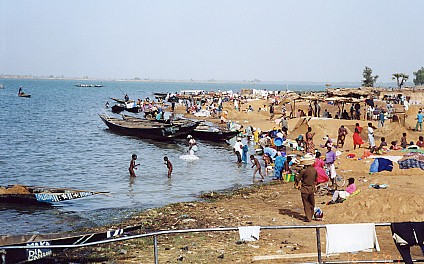
16/2/01 Pinasse, boats used here are built from large flat slabs of trees fashioned using an adze. The shape of the planks doesn't matter as others are simply cut to fit the gaps. Tarred and nailed together you wonder how they float, some being 30 metres in length with joints everywhere and hardly any structural beams. An easy form of transport in a desert country moving timber, sand, grains, animals and people. Many even larger ones poled along or with old truck engines chugging. The pointed ends move easily in the water though hard to turn. Into Mopti, 430 km, a major river transport hub and junction of the rivers to Bamako, Tombouctou and Djenne. Hundreds of these boats of different sizes, along with the tourist version, continually shuffle their position loading and unloading. Brightly dressed people clamber everywhere buying, selling or travelling. A people watchers haven of activity.
17/2/01 The river is now low and leading up to the biggest
festival of the Islamic calendar, the slaughter of rams. People are bringing
their sheep here to be onsold to traders for the Bamako markets.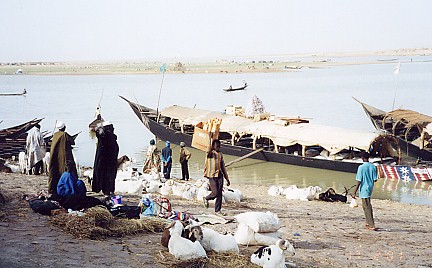 The dry banks of the rivers now home to nomads with their dismountable
grass huts, netting the increasing concentrations of fish from the receding
waters and cooking/smoking them on the rank grasses. These nomads move only
by water carrying animals, chickens, fish, houses, nets and themselves in
their boats. We took a small pinasse and visited four small villages extending
along the confluence of the two rivers and marvelled at their simple yet
efficient way of life.
The dry banks of the rivers now home to nomads with their dismountable
grass huts, netting the increasing concentrations of fish from the receding
waters and cooking/smoking them on the rank grasses. These nomads move only
by water carrying animals, chickens, fish, houses, nets and themselves in
their boats. We took a small pinasse and visited four small villages extending
along the confluence of the two rivers and marvelled at their simple yet
efficient way of life.
18/2/01 Mali seems to gather all the tourists to West
Africa, be they backpackers or upmarket seven day fly-ins. The centre of
this activity is Mopti, the hopping off spot for Tombouctou, Dogon Country
or Djenne. As such, problems that tourism brings with it are here. Children
asking for money or pens. Touts wishing to act as guides or take you to souvenir
sellers. Different prices for locals and tourists. All of which we have to
a large degree not encountered recently. We rode to Djenne to see the world's
largest mud building, a mosque, dating back to the 11th century but rebuilt
in 1905, and high on the list of must visit tourist places and charging a
town entry fee. Touts here at their worst, sellers of anything they can carry
to walk with you to annoy tourists into buying. Market day is tomorrow, rumoured
to pack the town with locals and tourists. 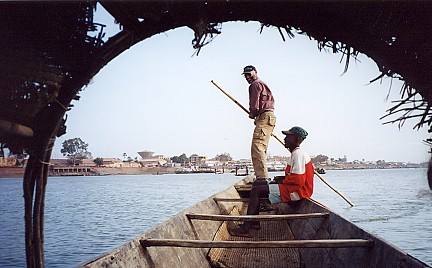
19/2/01 Djenne has kept its character with virtually all
buildings two storied mud brick, including our hotel where we are camped
on the roof, as authentic as possible. As a Canadian reporter explained to
us the theme of her story is mud. The mud for crops, pots, bricks, mortar,
render, streets. The whole town is just dried mud, and now in the dry, dusty.
The market grew slowly this morning, goods arriving by donkey or horse cart,
open vehicle or truck, gradually cramming the area in front of the mosque
with western goods and local produce. The people equally varied as their goods
with different jewellery, coloured cloth, turbans, hair styles and face markings
indicating their differences from each other. The tourists mingled and being
regular here are largely ignored by locals intent on their own dealings allowing
us to observe them in a more normal environment, than we usually see in markets,
where we are the only whites. 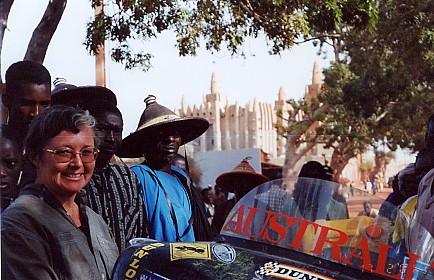
20/2/01 By morning the entire infrastructure of the market
had been removed to leave the mosque stand alone awaiting next Monday. We
left and within a few km's came across an overturned truck with produce scattered
everywhere. It looked decidedly like one that had left the market yesterday
piled high with maize, clothes, bicycles and sitting on top about 30 people.
The people were nowhere to be seen with police directing traffic around the
accident. Further down the road a bus had crashed through an electricity pole
and was now in the bush with luggage scattered and people sitting around.
We rode to the Burkina Faso border thankful of a mechanically sound vehicle,
not grossly overloaded and with good tyres. 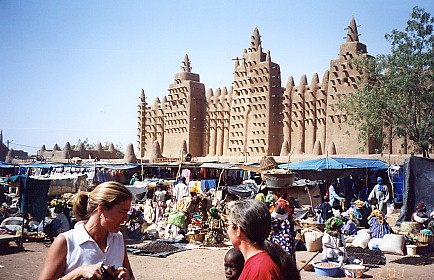
Move with us to Burkina Faso
or go to our next trip to Mali
|
Story and photos copyright Peter and Kay Forwood, 1996-
|